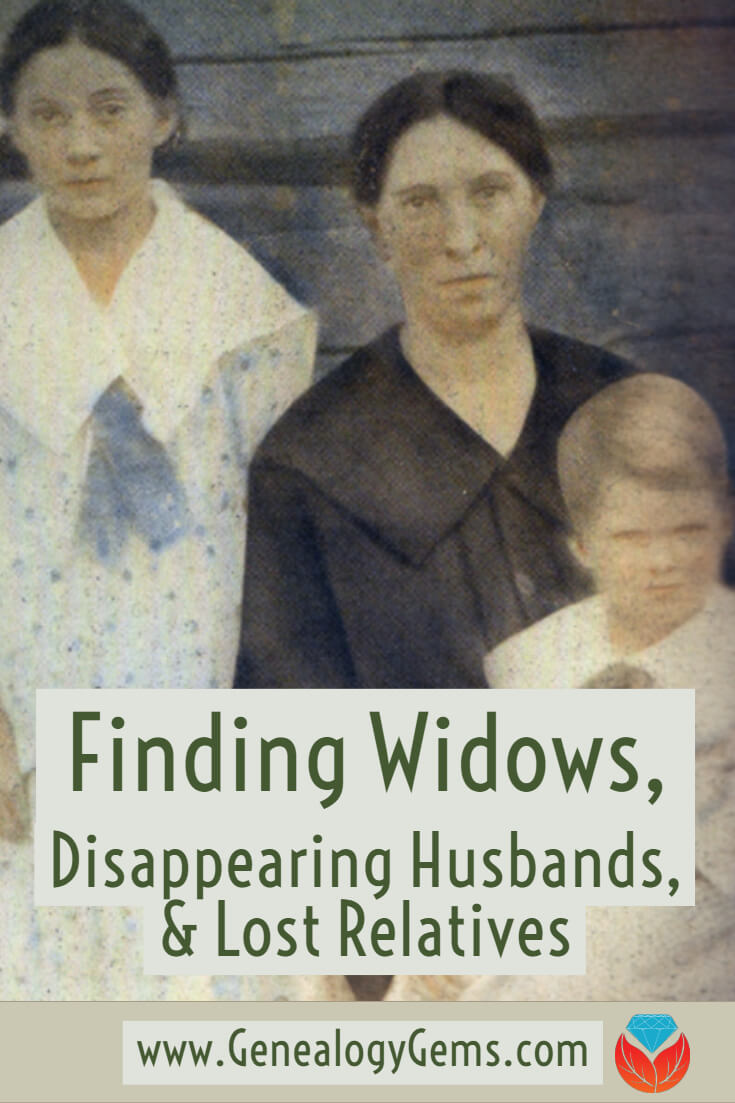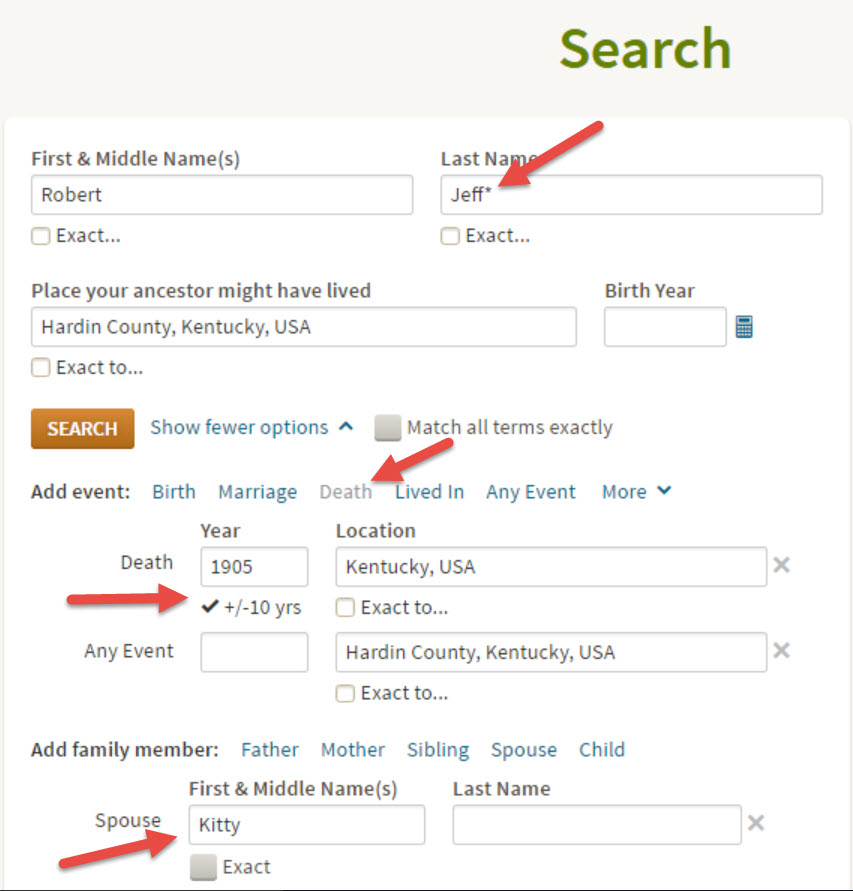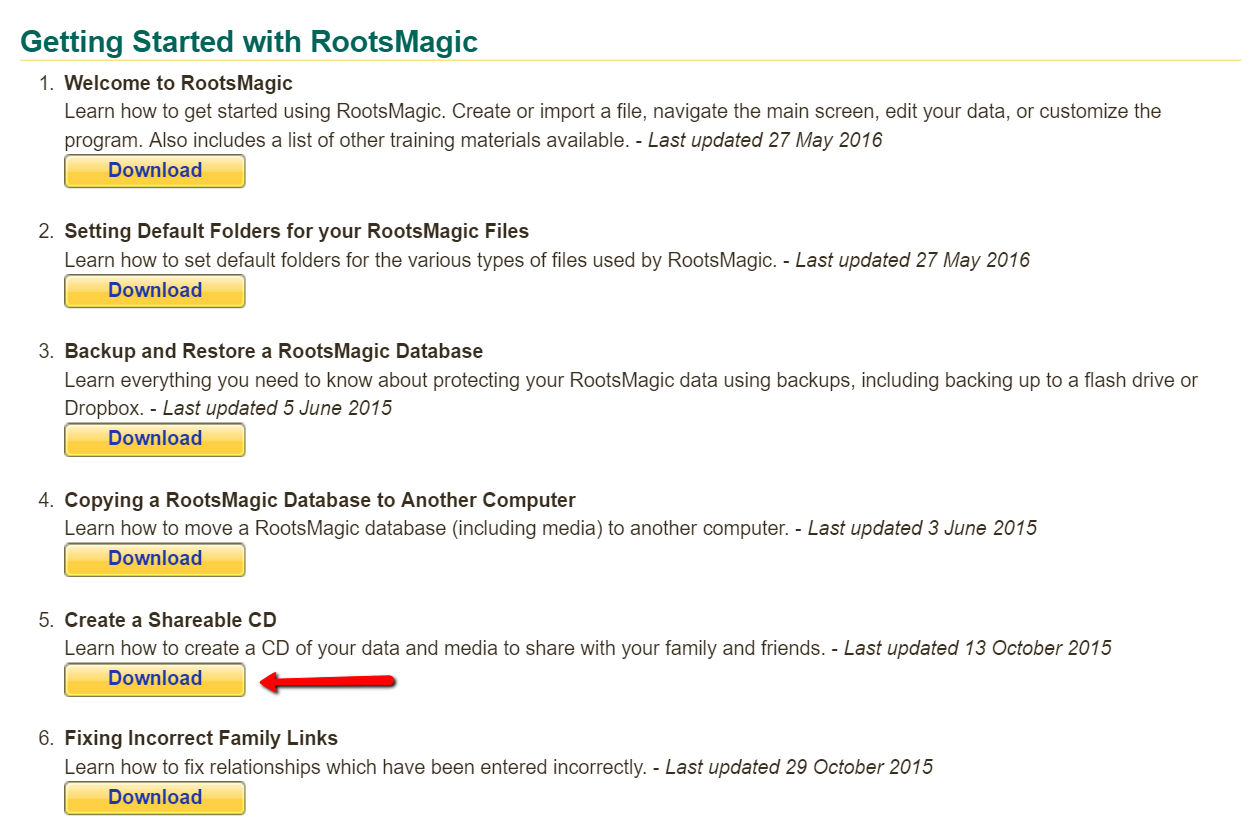Finding Widows, Disappearing Husbands, and Lost Relatives
Great-grandma may be listed as a widow in the 1900 federal census…but she might not actually be a widow after all. Women in the past sometimes claimed widowhood to protect their family’s good name. A recent reader’s question prompted this post for sharing some tips to finding widows, disappearing husbands, and lost relatives.

Widow or Not?
Genealogy Gems reader, Mary, wrote us the following comment:
“My grandmother Kitty’s first husband was Robert Lee Jeffries. They married in 1887 and had 4 or 5 children. He died in the very early 1900’s. She later remarried my grandfather, John, and they had four children together. All this took place in Hardin County, Kentucky. I cannot find when, where, or how her first husband died, or where he is buried. Can you help me?”
I think we can give Mary some tips to help her find Robert. As you read along, consider how these same tips and techniques could help you in finding widows, disappearing husbands, and lost relatives.
Finding Death Records in the Early 1900s
A death record is typically a good way to determine where someone went. If you can locate a death record for your lost individual, they aren’t lost anymore! Finding death records for the time period that Mary is asking about isn’t usually too difficult, unless there has been a record loss for that county. By doing a quick check on FamilySearch wiki for Hardin County, Kentucky, I learned that many records between 1852 and 1911 are missing, including some of the death records. That may be why Mary wasn’t able to find one.
When a death record can’t be found, there are many alternatives that we can exhaust. Cemetery records, newspaper obituaries, and probate records are just a few suggestions. But before we move into alternative records, something caught my attention.
Misspelled Names
With a last name like “Jeffries,” there could be several ways to spell it. Jeffrys, Jefferies, Jeffres, and perhaps many more. What can you do when you have a name, first or last, that could be spelled so many different ways?
One suggestion is to search by each of the possible name spellings, but another tool is to use an asterisk or wildcard. The first part of the surname Jeffries is always the same: J e f f. Whether you are searching records at Ancestry, Findmypast, or MyHeritage, you can use an asterisk after the last “f” to indicate you are looking for any of the possible surname spellings.

I didn’t find any great matches using the criteria you see in the image above, but I took off the death date range and Kitty’s name and found Bob Lee JeffERies living in his parents home in 1880 in Hardin County, Kentucky. Take a close look at this image:

Do you see the mistake? If you look at the digital image of the census, it spells the surname as Jeffries, however the record is indexed as Jefferies. Not to mention that Robert Lee is recorded as Bob Lee. This combination of name differences will always cause a little hiccup in our search process. This is why it is so important to consider name spellings when searching for records.
Even though using an asterisk didn’t produce a death record, you can see how using a tip like this can help when searching for any records online.
Alternatives to Death Records
Like I mentioned before, Hardin county had some record losses. Just because their death records may have been lost or destroyed, doesn’t mean the probate records were.
Using FamilySearch.org, I used the browse option to search probate record books in Hardin county, Kentucky. I found a record dated 25 Apr 1893, in which Kitty wrote her own will. [1] She mentions Lucy (possibly Robert’s mother found in the 1880 census) and others by name. What is strange is there’s no mention of a husband. I wondered if perhaps husband Robert had died before 1893. Unfortunately, there was no Robert Jeffries (or any variation) in the previous record books and the record book that Kitty appeared in was the last one available online.
When no will can be found, that doesn’t mean there is not a probate record available. The next step would be to visit the Hardin County probate office or State Archives to see if there is an estate packet available for Robert.
An estate packet is typically filled with all sorts of genealogy goodies! Receipts, list of heirs, and affidavits may shed light on many a burning question for your targeted ancestor.
The Disappearing Husband
Sadly, not all husband’s leave their families due to their demise. In the past, it was sometimes easier and more appealing to call yourself a widow or widower when your spouse left you. Kitty wrote a will in 1893 and did not mention a husband. In 1900, she was living in her father’s house and her children were divided up among the relatives, including her in-laws. Could Robert have left Kitty and the children? There may only be one way to know for sure.
Kitty remarried. To do that, either Robert had to die or she would need to be divorced. Divorce records can sometimes be located on a county level or at a state archives. I gave Hardin County Clerk of Courts a call and found out that divorce records between the years of 1804 -1995 are held at the Kentucky Department of Libraries and Archives. Their website provided details to ordering several types of records, including divorce records.
Looking in All the Wrong Places
Sometimes, we are so focused on one area that we can’t see past the end of our noses! Many of our ancestors lived on the borders of other counties. Hardin County, Kentucky is especially unique. It borders not only eight other Kentucky counties, but it also borders Harrison County, Indiana. It’s always a good idea to branch out to these nearby locations when you are having trouble locating records.
A Re-cap
When struggling to find a record for any targeted ancestor, try the following:
- Consider alternate name spellings and search for common nicknames.
- When there has been a possible record loss, search for alternative records that may hold the information you are looking for.
- Determine which counties/states your targeted location is bordering and search there for records as well.
Have you found a disappearing person or long, lost relative? If so, share with us (in the comment section below) your story and how you finally tracked the elusive person down. Maybe your story will help others still searching for that missing ancestor!
More Gems on Finding Missing Ancestors
How to Search Your Ancestors’ Other Spouses and Children
6 Sources that May Name Your Ancestors’ Parents
How to Save Time and Find the Ancestors You Are Looking For
Article References
(1) “Kentucky, Probate Records, 1727-1990,” digital images online, FamilySearch (www.familysearch.org : accessed 10 Aug 2016); record for Kitty A. Jeffries, 1893; citing Will Records, Index, 1893-1915, Vol. G, page 12.
Looking for a Living Relative?
Join Lisa Louise Cooke of The Genealogy Gems Podcast as she reveals 9 strategies to find your living relatives. Unleash your inner private eye and discover the tools that will help you connect with long lost cousins who may just hold the key to your genealogy brick wall!
This video class is part of Genealogy Gems Premium eLearning and includes a downloadable handout. Members can click here to watch right now. (Not a member? Click here to sign up!)
Disclosure: This article contains affiliate links and Genealogy Gems will be compensated if you make a purchase after clicking on these links (at no additional cost to you). Thank you for supporting Genealogy Gems!
This article was originally posted on August 24, 2016 and updated on April 18, 2019.
We Dig These Gems! New Genealogy Records Online
Here are this week’s fabulous list of new genealogy records online. Included are records for Australia, Great Britain, United States, and the Philippines.
AUSTRALIA – REGISTER OF INMATES. The Ballarat Benevolent Society Register of Inmates for 1860-1897 is an ongoing project by Brett Weinberg. This register is a transcription and can be viewed on the Ballarat Historical Society website. The list of inmates from the Ballarat Benevolent Asylum in Victoria, Australia are in alphabetical order. The index provides details of age, birth place, parents names, residence, arrival date in Victoria and any additional remarks.
GREAT BRITAIN – MILITARY. The British Royal Navy & Royal Marines Service and Pension Records 1704-1919 are available at Findmypast. These records include the original service and pension records of those serving in the British Royal Navy and Marines. Information may include name, discharge date, death date, next of kin, and parish.
UNITED STATES – IOWA – MILITARY. Membership records of the Department of Iowa Grand Army of the Republic are now free to search on FamilySearch.org. The records are arranged by county and then by posts within each county. The records include veteran’s name, residence, occupation, date and place of birth, date and place of death, cemetery where buried, war record, dates of enlistment and discharge, names of parents, spouse, and children (if given.)
PHILIPPINES – MANILA – CIVIL REGISTRATION. The Manila Philippines Civil Registration for 1899-1984 at FamilySearch.org includes images of births, marriages, and deaths. This collection is only partially indexed at this time and currently covers birth certificates between the years of 1900 to 1980.
UNITED STATES – INDIANA – BIRTH, DEATH, AND MARRIAGES. Three new databases for Indiana have been recently added to Ancestry. They are Indiana, Birth Certificates, 1907-1940; Indiana, Marriage Certificates, 1958-2005; and Indiana, Death Certificates, 1899-2011. Each database offers digital images of these certificates and are jam packed with great genealogy data for your family tree!
 Thank you for sharing this list with your favorite genealogy gurus! We love sharing good news about new genealogy records online.
Thank you for sharing this list with your favorite genealogy gurus! We love sharing good news about new genealogy records online.
Free RootsMagic Guides to Download and Share
 Free RootsMagic guides, called Magic Guides, are easy to download and share. This is just another reason why we love and recommend RootsMagic as the go-to genealogy software.
Free RootsMagic guides, called Magic Guides, are easy to download and share. This is just another reason why we love and recommend RootsMagic as the go-to genealogy software.
RootsMagic is downloadable genealogy database software that keeps all your family tree data nice and organized. It allows you to source your information, and create charts and reports. You can link to FamilySearch Family Tree and even access automated record hints at MyHeritage.com and Findmypast. Ancestry.com integration is coming soon; you can already import Family Tree Maker files easily.)
RootsMagic 7.0 can be downloaded for $29.95 by clicking here or you can try out the free version called RootsMagic Essentials.
Free Magic Guides
RootsMagic has many wonderful features you will want to try. Don’t learn by trial and error which can be frustrating. Download these free RootsMagic guides which make it easy to utilize the program to its fullest. These free guides are called Magic Guides. Each Magic Guide covers a single RootsMagic topic and includes step-by-step instructions with illustrations and tips. The guides can also be copied and distributed (but not sold) as handouts in groups when you teach others in RootsMagic classes, making them a perfect resource for genealogy societies.
You can find a list of all the Magic Guides available by going to the RootsMagic website and clicking on Learn at the top of the screen. Then, choose Magic Guides (handouts).

From installing to importing and everything in between, Magic Guides are a helpful addition to your using RootsMagic.
How to Get Your Free RootsMagic Guides
To download a guide to your computer, click the Download button under the title you want. Some devices are already set up to open the guide in PDF format. Other devices may require you to click Save Link As. If you are required to save the link, remember to save it somewhere you will remember. I suggest saving it to your desktop where it is easily accessible.

As an example, I downloaded the Magic Guide to Create a Shareable CD. I always enjoy sharing my new findings with the family and RootsMagic makes it so easy to do. The guide to creating a shareable CD is four pages long. It offers instructions on how to burn it now or burn it later, which is really nice in case I get distracted!
Here’s What I Learned from Free RootsMagic Guides
One thing I really love about these guides are the tips. In this guide, I learned that when creating a CD, you are making an exact copy of your database. That means all your private facts and notes that you may not want to share with the entire family, will be visible. With a few quick steps, the guide walks you through how to exclude these private facts and only share what you want to. Isn’t that great!
Share this Free Resource
If you have a friend who is new to using RootsMagic, be sure to share with them how they can use the free RootsMagic guides to enhance their experience. Share this article on Facebook or tweet about it! After all, everyone loves good news!
More Gems on RootsMagic
RootsMagic Review: Why I Use It
RootsMagic for Mac Users and More RootsMagic News
RootsMagic Update for FamilySearch Compatibility
